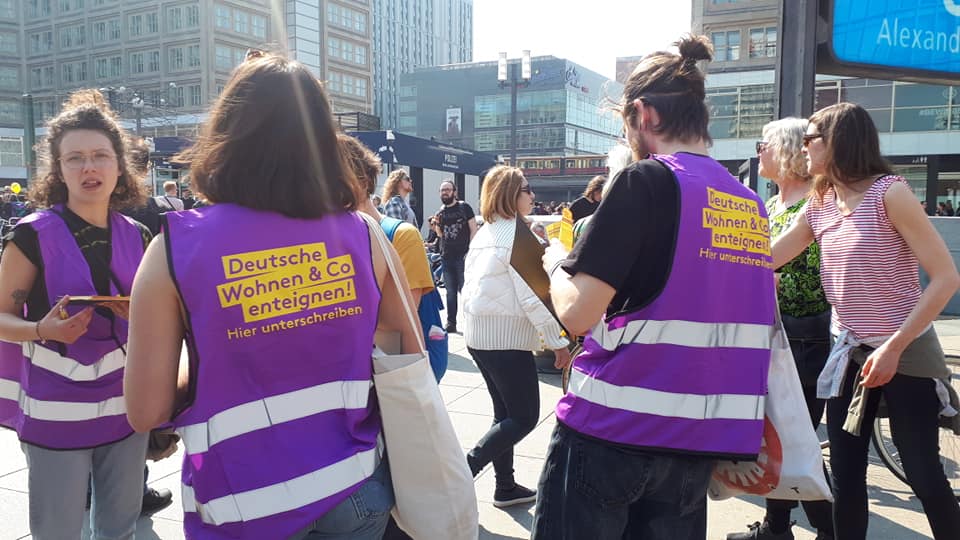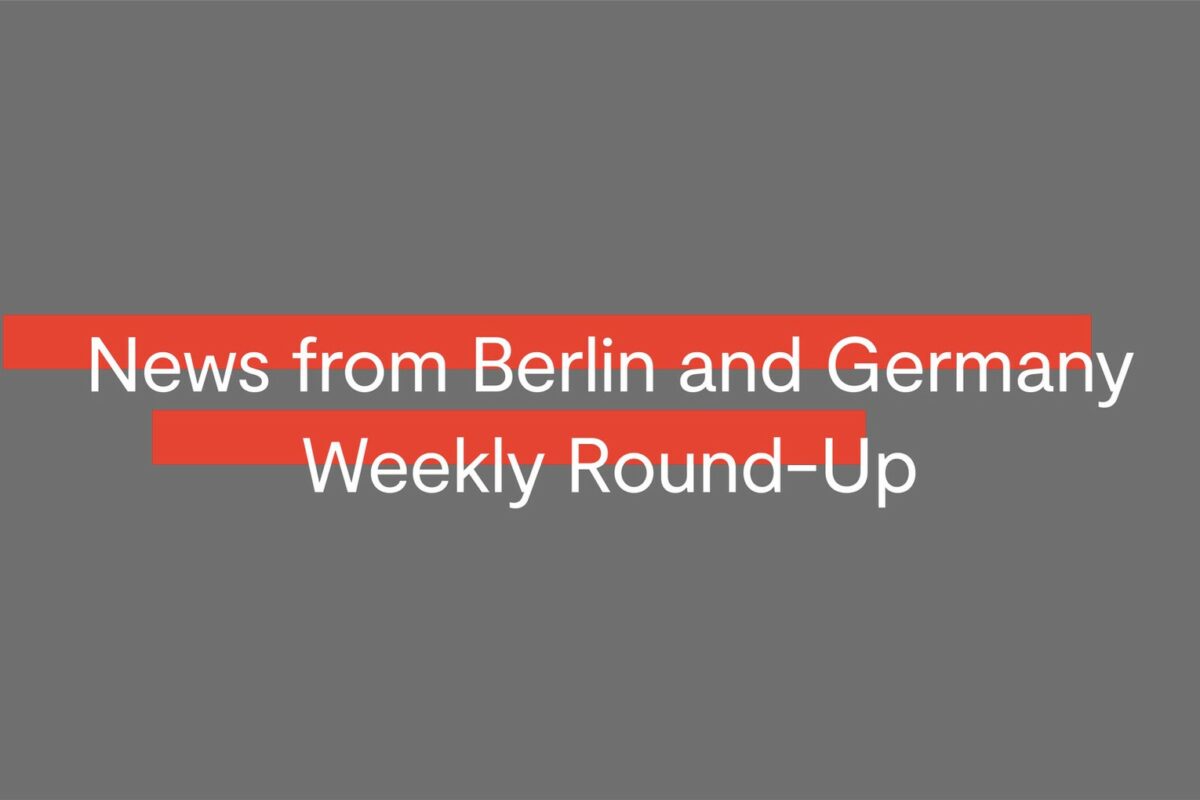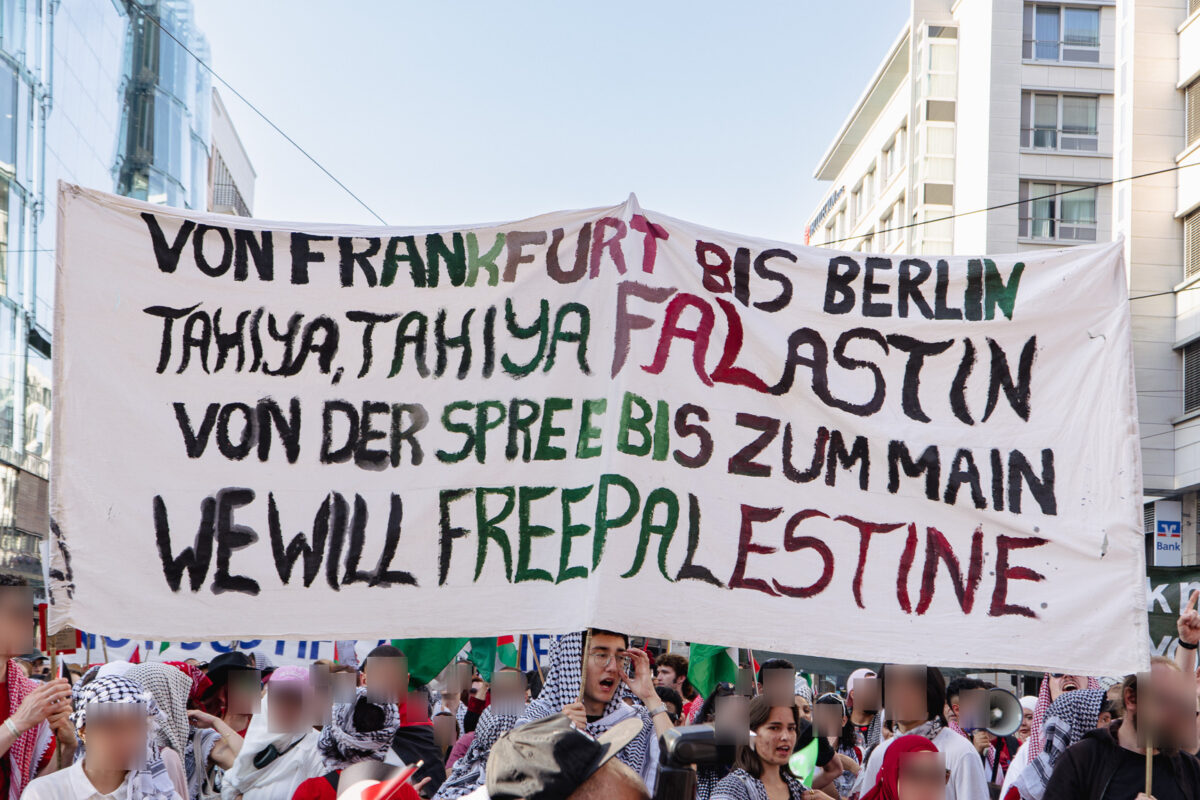The success of the Berlin initiative Deutsche Wohnen und Co Enteignen (DWE) has made a furore world wide. Around 60% of Berliners who were eligible, voted at a referendum on 27th September 2021 for the socialisation of large real estate companies.
The path to this result was long and rocky. First, signatures had to be collected in two phases. In the first phase, 20,000 signatures were required. Many more were collected, namely 77,000. In the second phase – between April and June 2021 – 175,000 signatures had to be collected. This requirement was clearly exceeded with 350,000 signatures.
An intensive election campaign followed with rallies, street actions and door-to-door chats leading to a brilliant referendum triumph. This was only possible because hundreds of activists were motivated to join. The strategy was planned by the Sammel-AG (a working group for collecting support). Hannes Strobel discussed this with activists Judith and Leonie.
Hannes: What is the Sammel-AG, and what is your function in the campaign?
Judith: The Sammel-AG is one of six working groups in the campaign. At the moment its core has ten to 15 people. The working groups are responsible for different tasks. For example, the Action-AG is responsible for rallies and demos, the Publicity-AG for press work and social media, and so on.
In the first phase of collection, the Sammel-AG was the group where most of the necessary signatures were collected. But in the second round, we needed many more signatures. You can’t manage that with 10 or 20 activists. It was clear that we needed a Berlin-wide structure to manage this.
Leonie: Our concept finally came together. We planned the collection in four pillars. Firstly collection at the workplace or University, however this was unfortunately impossible because of Corona. Secondly, the large coalition partners like tenants’ associations, trade unions and parties which contributed some of the signatures.
Thirdly the occasional activists who integrated well with the help of our App. Hundreds of collection activities were entered into the App, which you could spontaneously join. And fourthly – the most important pillar – was our own structures. From the very beginning, we didn’t “just” want to collect signatures, but we wanted to politicise people and to build sustainable structures.
Hannes: What do the structures that you have built look like and how have you done it?
Response: We were clear that collecting signatures in the second phase must be decentralised. It was about managing to create contact points everywhere in Berlin, so that people could set off collecting independently. So we had the idea of so-called “Kiez teams”. This was a group which coordinates the collection of signatures locally and looks after the logistics; but it also considers how we can grow.
This now has at least such group in all 12 districts of Berlin, like Tempelhof-Schöneberg. In some districts like Friedrichshain-Kreuzberg there are two – one each for Kreuzberg and Friedrichshain.
Many people without much previous political experience took part in the Kiez teams. Some because they were personally affected – for example because their house had been sold. Others because the subject of rising rents was important to them. They gained their first political experiences in our structures. Many of the new people say that they have learned and picked up a lot. Working in the Kiez teams in solidarity helped that a lot of course.
Leonie: At the beginning there were real, physical meetings, where we could invite people throughout Berlin to a central place. The first was at the end of 2019, before Corona. At this meeting, we presented our guidelines. This was a guide into what the first steps of organising a Kiez team could look like. After that, people came together by district and discussed together where collections in their district could make sense. And then Corona came.
Hannes: Did Corona affect the campaign? How did you deal with the situation?
Leonie: At first there was a complete standstill. Our concept was based on meeting people, that they could come together. That became possible. Finally, we reacted well to this Corona situation with digital meetings for new people.
The meetings happened in the evening online. They were well structured, diverse with short inputs from the campaign. Above all, these meetings were interactive. They went quickly into small groups where the people could discuss what matters. The meetings generated enthusiasm to join in, making people highly motivated.
The good social media work of the Publicity-AG has helped us. Nearly 80% of people came to the meeting for new people via Facebook, Instagram and Co. Seventeen people took part in the first meeting in June 2020; in September 40 people; in October 100, then 120, 150. Finally between 600 and 700 people flowed into the structures of DWE, all of whom had an initial motivating meeting. We then passed contact details of new people to the Kiez team or AG, where they wanted to work. The Kiez teams then contacted and integrated the interested people.
Judith: This is how the Kiez teams grew rapidly. Until then at most five or six people were active in the Kiez teams – this figure multiplied. This was really exciting. In Kiez teams like Neukölln, ten to 20 new people came every week. For many people it was totally motivating to get politically active where they live, in a district that they know.
Generally, the meetings took place only online. That has advantages and disadvantages. On the one hand, some people were surely left out, such as older people who don’t have so much technical affinity. This was hotly discussed at the meeting for Kiez teams. On the other hand, for many people, it offered a possibility to come. That saved us through the Corona winter.
Leonie: it was noticeable that the Kiez teams that advanced most quickly were those where individual cart-horses took the lead.
Hannes: What do you mean by “cart-horses”?
Leonie: Cart-horses are individual people who pro-actively organise Keiz teams and invited people to the first meeting. Some cart-horses came out of the Sammel-AG. The dynamic was to think about the concepts. The educational work took place in the Sammel-AG. Then people took this knowledge and used it to build a Kiez team.
Judith: They also took care of reconnecting with the campaign as a whole. That is they took on an important role of mediator. They were also integrated new people. A critical point was to bring new people to the point where they could take over tasks and responsibilities themselves. This was sometimes very difficult. This meant that the cart-horse needed a good overview and instinct who could take over which tasks. It was about emboldening people, for example, to moderate a plenum of the Kiez team, to empower them, and to enable people to gain experience.
Hannes: that sounds as if many of the individual people were there by chance. Is that correct?
Leonie. No. We took a very strategic approach. At the beginning, collecting signatures and the corresponding structures were mocked a little by some in the campaign. It was viewed as something that had to be done but wasn’t so important politically, it was just a support service. This meant that we could act quite freely as the Sammel-AG.
At first we produced “socio-spatial” potential analyses. We went through every single district with criteria like the number of renters, the stocks of the housing concerns that we wanted to expropriate, past election results, etc. We wrote a strategy plan which we implemented step by step.
For example, at first there was only one Kiez team for all the districts of Mitte, Wedding, Moabit, Tiergarten and Prenzlauer Berg. But our potential analysis clearly showed that it made sense to build a Kiez team in each of these districts. We decided to immediately set up a Kiez team for Mitte, one for Wedding and so on.
At first the people who were active in the original large Kiez team didn’t find it so cool that we’d taken this decision without them. But the decision stood, as it was clear that it made sense.
On top of this, different workshop formats were developed by the Sammel-AG which always had the aim of teaching multipliers with ‘Train-the-Trainer’ formats. For example, there were subjects like “how do I collect signatures well?” or workshops about argumentation.
Judith: That functioned really well. There was then a pool of activists in the Kiez teams who could carry out these workshops for new people. The expertise needed to give a workshop multiplied in the campaign.
It was always clear that there was no template that you could use in every Kiez team. Each district has its own demographic structure and idiosyncrasies. It worked a little different everywhere. We had a place in the Kiez team council where we could comprehensively swap experiences.
Hannes: What was the importance of the Kiez team council?
Judith: It became clear very quickly that we needed a place for networking and sharing experiences of the Kiez teams. The Kiez team council was consciously set up as a parallel structure to the DWE plenum, so that the Kiez teams could gain a greater weight and their own voice in the campaign. At first, parts of the campaign looked down on the Kiez teams.
The first Kiez team council met in December 2020. Each Kiez team sent two or three delegates. As Sammel-AG, we moderated the networking and exchange of knowledge between the Kiez teams, and introduced information from the campaign as a whole. For example, “how is the socialization-AG currently discussing the socialization law?”
The Kiez teams could learn from each other and swap skills – for example, how you could best integrate new people or the best strategies for collecting, and later for the election campaign.
Hannes: Speaking of the election campaign, what was your role as Sammel-AG?
Judith: That was a quite difficult phase. Until the end of June 2020 we had been collecting signatures, and then the election campaign started at the beginning of August. Until the end of the second collection phase, it seemed very tight whether we would collect enough valid signatures. This meant that we didn’t grapple with the election campaign until quite late.
But it was clear that the Kiez teams must carry out the election campaign. Who else was there? As Sammel-AG we saw our role to carry on coordinating the Kiez teams and to look after knowledge transfer. The election campaign showed how important it had been to build local structures.
Leonie: There were also conflicts. For example, some in the campaign were critical of building structures in the outskirts of town. This was supposedly a waste of energy and resources. Instead it was proposed that people from the city centre should occasionally travel there to collect signatures. But a large majority in the campaign agreed that there was no sense in neglecting the outer districts.
Take Marzahn-Hellersdorf. Nothing came out of there. So, relatively early we went to the support-AG and asked if they were interested in supporting us. Because it was clear to us that it would be incredibly time-consuming and difficult and we didn’t have the capacities to work there, although we felt that this district was really important.
Hannes: What next for DWE, and what is your role as Sammel-AG?
Leonie: If we had lost the referendum, it would have been very unrealistic to sustain the structures that had emerged. Now it’s going forward somehow. Without the pressure of collecting signatures or having to win an election campaign, we have the chance of rethinking again. There is the possibility of us diversifying as a campaign. The pillars now take centre stage: carrying out lobby work for a socialization law. Organising and considering our own structures,
Judith: At the beginning we intended to include more local tenants’ initiatives in the collection. But it became clear relatively early that many people didn’t have the time or capacities for this as they were busy with their own fights and conflicts.
Now, together with the Kiez teams, we are asking ourselves how more people can be part of our structures? How can the Kiez teams become more diverse? As the Sammel-AG we also ask ourselves whether we should continue mediating between the Kiez Teams and the campaign? The Kiez teams are now developed groups and have become more self-confident. For certain things, we’re not needed so much.
This interview originally appeared in German in Común magazine. Translation: Phil Butland. Published with permission.



